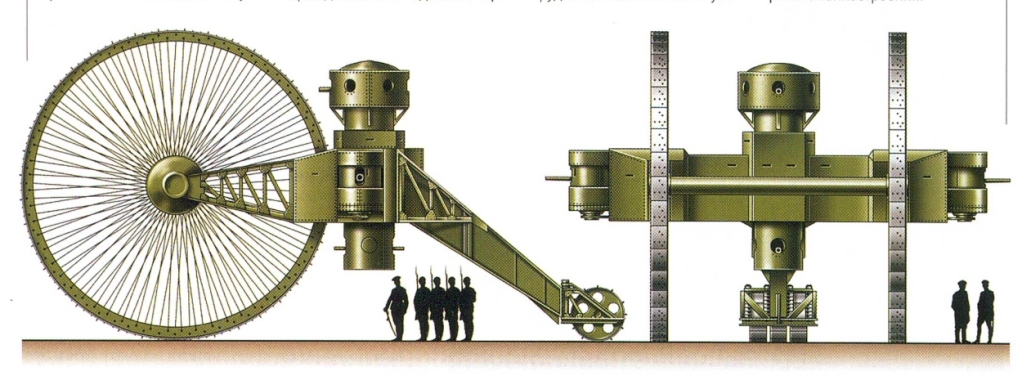
|
|||||||||||||||||||||||||||||||||
The history of the Lebedenko starts in 1914 with the engineer N. Lebedenko, who was at that point employed in a private firm, that worked for the Russian War Department, designing artillery devices. Lebedenko himself, with the aid of N. Zhukovskiy and his nephews, B. Stechkin and A. Mikulin, came up with the idea (originally thought as a sort of enlarged gun-carriage) of a motordriven battle machine, weighing some 40 tons, running on one small double-wheel, and two very large spoked wheels, almost 9 meter in diameter, in a tri-cycle arrangement. The big wheels were attached to the hull, shaped like a tuning-fork, which tapered down to the double wheel, mounted in the rear, which provided the means for steering the vehicle. The designers hoped that this original configuration would make it possible for the vehicle to cross practically all obstacles. They initially called the vehicle Nepotir, but came to be known as the Lebedenko, after the designer. (Sometimes it was nicknamed "The Tsar ", after the financier.)
But who would finance this project? A small working wooden model of the Nepotir was made, driven by a spring motor taken from a gramophone. Then the model was demonstrated to Tsar Nikolaj, who was much impressed when the toy made it across some scale obstacles, i.e. a number of thick books. He promptly ordered the designers to go ahead with the project, and allocated the needed funds himself. Construction of the full-scale Lebedenko started. The drive assembly consisted of two 240 hp Maybach engines, one for each big wheel. The wheels themselves (designed by Zhukovskiy) had a T-shaped metal mid-section. A wooden overlay was then fastened to the shelf of the T-beam. The drive itself was very simple. Each engine drove an automobile wheels, who was in it’s turn pressed down (by means of a railway carriage spring) until it touched the wooden overlay of the big wheel, and by counterrotating, the automobile wheel transferred the energy from the engine to the big running wheel. (In case of over-heating, the driving wheels disengaged and protected the engine from seizing.) It was thought that the Nepotir should be able to reach a top speed of some 17 km/h – which was pretty impressive compared to other WW1 AFV:s. The hull of the vehicle would have one top-mounted centrally placed turret, equipped with MG:s and/or light cannons, giving the Lebedenko a total height of some 12 meters. In addition to this, at the outer flanks of the hull, small MG sponsons was to be placed. There was also a small weapons turret placed underneath the belly of the beast. The construction progressed pretty quick and at the end of July 1915, the Nepotir was ready for it’s first trials. Because of it’s weight and size, it was designed to be transported in sub-assemblies, to be assembled again before action at the front (like it was later envisioned for the huge German K-Wagen). This procedure was followed, and the sub-assemblies were transported to the testing ground, some 60 km from Moscow. At the re-assembly it was found out that the weight of the machine exceeded calculations with some 50%, due to the use of thicker metal. In August the test began in front of a high commission. It started well. The vehicle moved well over some firm ground, crashed a tree, but then went into a soft patch, where the small double wheel got stuck in a ditch. Soon it was obvious that the engines were to small, as they were unable to free the rear double wheel. After this fiasco, two of the designers, Mikulin and Stechkin, worked on equipping the vehicle with more powerful engines, but this plan was never fulfilled. The military had decided against the project. It was simply too expensive, it had thus far cost some 250.000 roubles. Also the vehicle (and then primarily it’s wheels) was deemed to be too vulnerable to artillery fire, which probably was quite true. (And by this time both France and Britain were near to completing new types of all-terrain armoured fighting vehicles, running on caterpillar tracks.) The Lebedenko stood there, bogged down, for the rest of the war, but was finally scrapped in 1923. Technical Data Weight ca 60 tons
|
|
Droit d’auteur La plupart des photographies publiées sur ce site sont la propriété exclusive de © Claude Balmefrezol Elles peuvent être reproduites pour une utilisation personnelle, mais l’autorisation préalable de leur auteur est nécessaire pour être exploitées dans un autre cadre (site web publications etc) Les sources des autres documents et illustrations sont mentionnées quand elles sont connues. Si une de ces pièces est protégée et que sa présence dans ces pages pose problème, elle sera retirée sur simple demande. Principaux Collaborateurs:
Nb
de visiteurs:7894815 Nb
de visiteurs aujourd'hui:144 Nb
de connectés:74 | |||||||||||||||||||||||||||||||





.JPG)
.JPG)
.JPG)


.JPG)
.JPG)
.JPG)



